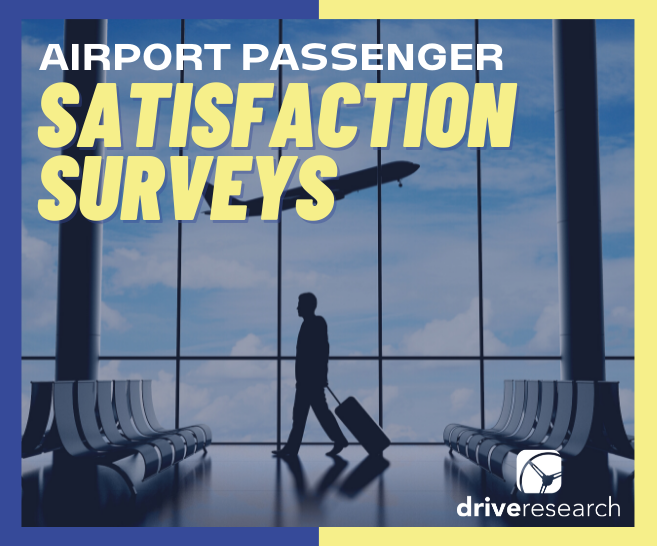As with most industries, it can be a head-scratcher as to why customers choose a competing airline over yours and vice versa.
For this reason, airline passenger satisfaction surveys can be a great asset to understanding consumer experiences, expectations, behaviors, and more.
The truth is, during these evolving times passengers are considering a variety of factors when planning their travels, such as:
- Ticket prices
- Airline awareness and reputation
- Brand loyalty
- Cleanliness
- Flying history (i.e. frequent fliers)
- Travel time (i.e. nonstop route availability)
In this blog post, our travel and tourism market research company will explore the details of airline passenger satisfaction surveys. We will give a definition, outline the process, and list some key benefits that conducting an airport satisfaction survey can provide.

What is an airline passenger satisfaction survey?
An airline passenger satisfaction survey refers to a type of market research that gathers feedback and information from passengers who have completed a trip with your airline or at your airport.
Typically, a survey is sent a short while after the trip in an effort to learn more about the passenger’s flying experience.
As with any market research that is conducted, defining the goals and objectives of the study is the number one priority.
Before discussing things like price, timelines, or question types, a research team needs to know the survey goals and how the results will be used. Without clear objectives, you’re just shooting in the dark.
In addition to defining the goals and objectives, specifying the desired audience is another important first step.
- Do you prefer to survey only members of your loyalty program?
- Do you wish to survey all types of passengers?
- Are there any passenger types you wish to exclude from the research?
Ultimately, the kind of audience you wish to survey will affect how the research team drafts the survey.
What is the process for an airline passenger satisfaction survey?
When conducting an airline passenger satisfaction survey for our clients, Drive Research follows these 5 steps!
- Proposal: During this step, the goals and objectives of the research are defined. The client team will share what they’re looking to gain from the research. The research process is outlined and the project details are fine-tuned.
- Kickoff: This is the first official step into starting the research! The client team will meet with the research team to confirm the goals and objectives, and discuss the next steps to ensure everyone is on the same page.
- Survey design and testing: Here is when the survey is drafted and fine-tuned. Once the survey is finalized, it is programmed into survey software and tested thoroughly by our research team.
- Fieldwork: When the survey is fully tested, the team begins fieldwork. The research team will make sure questions are being understood as intended. Fieldwork can be completed over a span of a few days or it can be kept open for a longer amount of time, depending on how the client wants to view the data and results.
- Analysis and reporting: Once fieldwork is completed, analysis and reporting begin. Depending on the type of report, a topline summary can be completed within 24 hours while a comprehensive market research report takes roughly 2 weeks to complete.
With an airline passenger satisfaction survey, we recommend putting a brand tracking study in place. This allows for benchmarking and understanding how passengers’ perceptions and satisfaction are changing over time.
Looking for more insight into tracker surveys? Watch this short video.
What are the benefits of an airline passenger satisfaction survey?
As a market research company, Drive Research could list the benefits of market research for days on end.
No, really, we could -- and we did. Read What are the Benefits of Market Research?
But to keep things brief, here are some benefits to conducting an airline passenger satisfaction survey.
1. Benchmarking
To understand passenger satisfaction, you must first set a market research benchmark (or if you’re into science, a ‘control group’ if you will).
Conducting your first passenger satisfaction survey sheds light on what you’re doing right and what passengers think you could be doing better.
With the first wave of surveys completed, you’ll have data to compare to later on to see how things have improved.
2. A fresh perspective
A third-party market research company, while executing a survey from beginning to end, will continuously provide you with unique, fresh, and unbiased recommendations.
We don’t have skin in the game, so we can share real, unfiltered insight on how you can improve your passenger experience.
3. Competition comparison
Asking respondents how their experience compared to other competitors can shed light on how you stack up against others.
Wondering what the other guys are doing, and how you can respond? The satisfaction survey can get valuable information from respondents on how they viewed the competition.
These are just some of the benefits that conducting an airline passenger satisfaction survey can provide your organization. There really are so much more!
Ready to explore them in more detail? Contact our team below.
Conduct an Airline Passenger Satisfaction Survey with Drive Research.
Drive Research is a travel and tourism market research company with experts who work with a variety of organizations across the country. Delivering key insights and actionable recommendations are at the heart of what we do.
Are you interested in learning more about our market research services? Reach out through any of the four ways below.
- Message us on our website
- Email us at [email protected]
- Call us at 888-725-DATA
- Text us at 315-303-2040

Devan Grant
Devan's love for learning serves him well as a market research professional. With two years of both quantitative and qualitative research in the healthcare space under his belt, he knows what it takes to answer some of the toughest market research questions.
Learn more about Devan, here.

